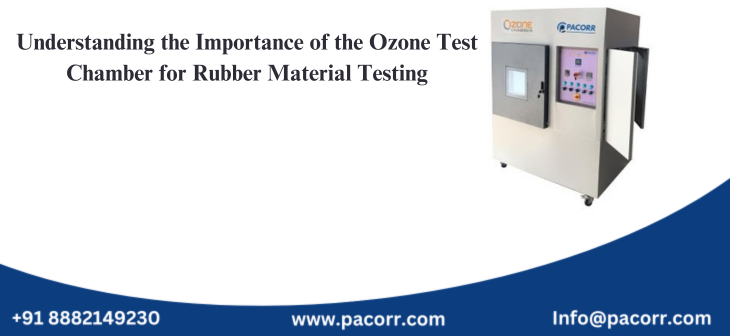
Rubber is an essential material in various industries, from automotive to aerospace. However, like many other materials, rubber is prone to wear and degradation due to environmental factors. One of the most damaging elements for rubber products is ozone exposure. Ozone, a naturally occurring gas in the atmosphere, can cause cracks, brittleness, and deterioration in rubber material, leading to product failure and reduced performance.
To address this challenge, Pacorr’s Ozone Test Chamber has become an indispensable tool for testing the durability of rubber material and products. In this blog, we will discuss the importance of ozone resistance testing, how the ozone test chamber works, and how it can help ensure the quality of rubber material.
What is Ozone Resistance Testing?
Ozone resistance testing is a critical process that measures the durability of rubber when exposed to ozone gas. Ozone attacks the double bonds in the rubber polymer, leading to the development of surface cracks that compromise its elasticity and strength. This is particularly relevant for products like tires, gaskets, hoses, and seals that are regularly exposed to outdoor conditions.
By simulating real-world exposure to ozone in a controlled environment, a manufacturer can predict how rubber material will behave over time. This allows preventive measures to be taken or necessary adjustments made to ensure the longevity of the product.
How Does Pacorr’s Ozone Test Chamber Work?
Pacorr’s Ozone Chamber is designed to simulate the effects of ozone exposure on rubber material under specific environmental conditions. Here’s a step-by-step breakdown of how the machine operates:
- Controlled Environment Simulation: The test chamber generates ozone gas at precise concentrations that mimic real-life environmental conditions. The ozone concentration, temperature, and humidity levels are all customizable, allowing for accurate and repeatable testing.
- Test Specimen Placement: A rubber specimen is mounted in the chamber on a rotating or static holder, depending on the test requirements. This setup allows the entire surface area of the specimen to be uniformly exposed to ozone.
- Monitoring and Testing: During the testing process, the chamber monitors the behavior of the rubber material under ozone exposure, typically over an extended period of time. As the test progresses, the specimen is inspected for cracks, discoloration, or changes in texture.
- Data Analysis: Once the test is complete, the data collected provides insight into how the material responds to ozone, helping a manufacturer understand the potential lifespan and performance of the product.
Why Ozone Testing is Essential for the Rubber Industry
Rubber products, particularly those used in outdoor applications, are constantly subjected to environmental stresses, including ozone. The damage caused by ozone can lead to premature product failure, which can be costly for a manufacturer and potentially hazardous for consumers. Here’s why ozone testing is critical:
- Enhanced Product Durability: Ozone testing helps ensure that rubber material can withstand environmental stresses, reducing the risk of cracks and damage. This directly translates into a longer-lasting product and improved safety.
- Regulatory Compliance: Many industries have stringent quality standards and regulations regarding ozone resistance. By conducting ozone testing, a manufacturer can ensure that the product meets or exceeds these regulatory requirements.
- Cost Savings: Identifying potential material weaknesses early in the design or production phase can save significant costs associated with product recalls, replacements, or liability claims.
Applications of Pacorr’s Ozone Test Chamber
Pacorr’s Ozone Test Chamber is used across a variety of industries, including:
- Automotive: A tire, belt, hose, or seal is tested to ensure it can withstand long-term ozone exposure without cracking or degrading.
- Aerospace: Rubber components used in an aircraft are subjected to ozone testing to ensure safety and performance.
- Construction: A seal, gasket, or other rubber material used in construction must pass ozone tests to ensure it can survive in outdoor conditions.
- Medical: Rubber material in a medical device is tested to ensure longevity and reliability in various environmental conditions.
Conclusion: The Pacorr Advantage
At Pacorr, we understand the critical role that ozone resistance plays in ensuring the quality and durability of rubber material. Our ozone chamber is designed with precision, offering customizable testing options to meet the specific needs of different industries. By using our ozone test chamber, a manufacturer can gain valuable insights into the longevity of the product and prevent costly product failures.
If your company relies on rubber products, it’s time to ensure they can withstand the test of time and ozone. Contact us today to learn more about our ozone test chamber and how it can help you maintain the highest standards of product quality.
Thanks to Pacorr Testing instruments, we have all the required quality testing instruments that have helped us to ensure the best quality delivered to our clients.

Danish
Fair Exports Pvt. Ltd.

